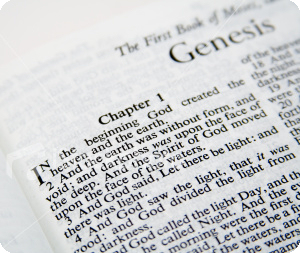MARIANO TOMATISWONDER INJECTORWriter of science with the
|
An automatical analysis of Kruskal paths It is impossible to count the vast number of methods of finding God. One path deals with mathematics. Pick up a Bible, read the first verses and choose a word from the first one: 1. In the beginning God created the heaven and the earth.  Count the letters in that word. If the word has 4 letters, go forward 4 spots. If it has 3, advance 3. For example, if you choose the word CREATED (7 letters), jump over the words THE (1), HEAVEN (2), AND (3), THE (4), EARTH (5), AND (6) and you will end on the word THE. When you got to the new word, count the letters in it, and go forward that amount of words. Repeat the sequence until you got to the third verse, then stop. No matter what initial word you have chosen, you will always end at the word GOD. The trick can be explained in terms of Markov processes (1), and was discovered in the 1970s by Princeton physicist Martin Kruskal (1925-2006) and first discussed for a magic trick by Ed Marlo (1913-1991) in February 1975. (2) In February 1978 Martin Gardner (1914-2010) wrote a column about it in Scientific American. (3) John Allen Paulos applied the principle to word chains in his book Once upon a Number: Consider a holy book with the compelling property that no matter what word from the early part of the book is chosen, the following procedure always leads to the same climactic and especially sacred word: Begin with whatever word you like; count the letters in it; say this number is X; proceed forward X words to another word; count the letters in it; say this number is Y; proceed forward Y words to another word; count the letters in it; say this number is Z; iterate this procedure until the climactic and especially sacred word is reached. (4): The choice of the Bible was meant lightheartedly: it is a book likely to be in many homes and the trick may be used in a semi-mystic setting. The same trick can be performed with any other text.  I have developed a tool to automatically analyse a set of verses. Given a first, some central verses and a last one, it examines all the words of the first verses, simulating a path through the text until the first word reached on the last verse. Click here to play with Automatical analysis of Kruskal paths _________________ (1) Jeffrey C. Lagarias, Eric Rains and Robert J. Vaderbei, “The Kruskal Count”, 12.10.2001. (2) See Ed Marlo, “Approaches and Uses for the Kruskal Kount”, 15.2.1975 (in Charles Hudson, “Card Corner” in The Linking Ring, December 1976, pages 82-87.) Martin Gardner and Karl Fulves, “The Kruskal Principle” in The Pallbearers Review, June 1975. (3) Martin Gardner, “Mathematical Games” in Scientific American, N. 238, February 1978, pp. 19-32. See also Martin Gardner, “Ten Amazing Mathematical Tricks” in Math Horizons, Vol. 6, N. 1, September 1998, pages 13-15.26, Martin Gardner, From Penrose Tiles to Trapdoor Ciphers (Chapter 19), W.H. Freeman Co., New York 1988 and John M. Pollard, “Kruskal’s Card Trick” in The Mathematical Gazette, Vol. 84, N. 500, July 2000, pp. 265-267. (4) John Allen Paulos, Once Upon a Number — The Hidden Mathematical Logic of Stories Basic Books, November 1998, p. 64. |